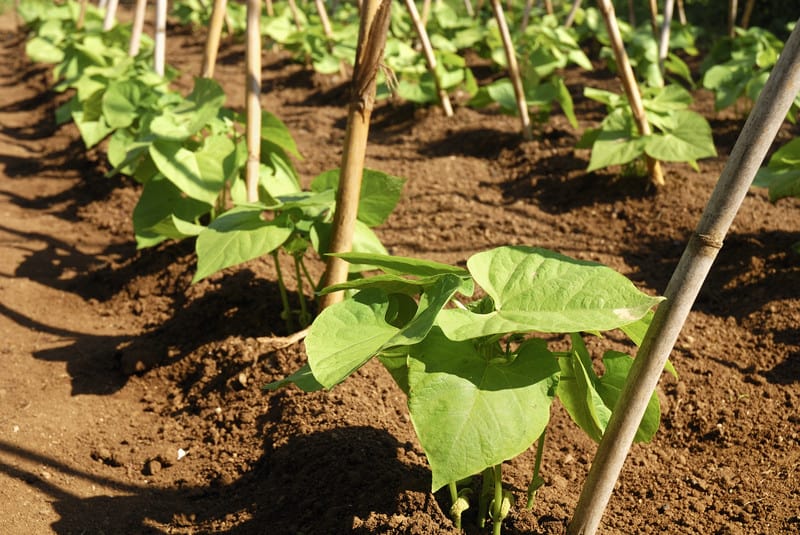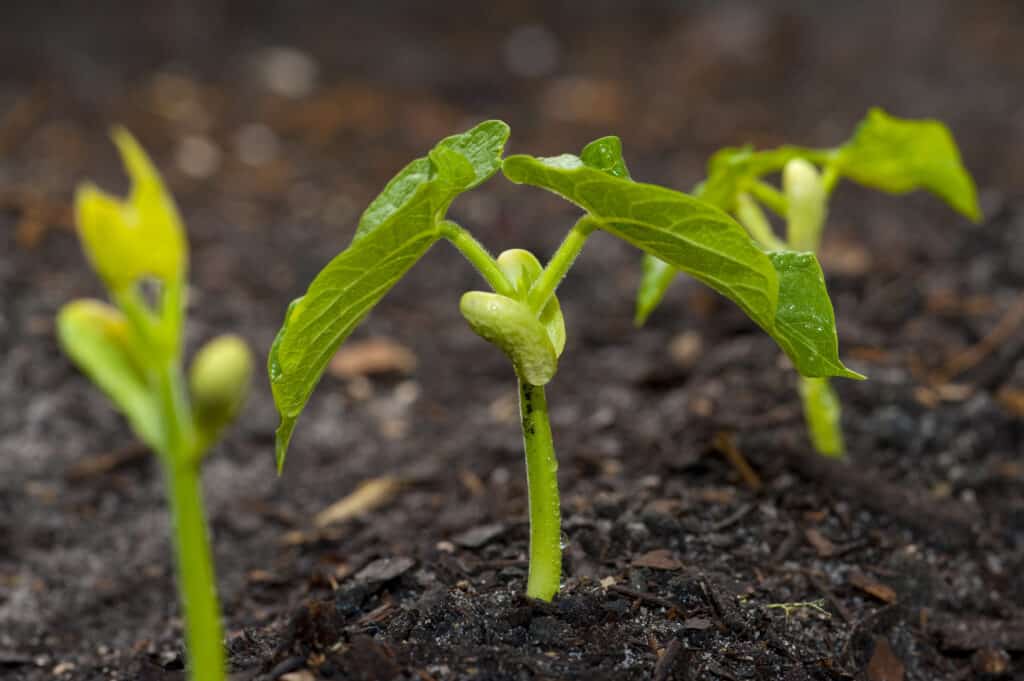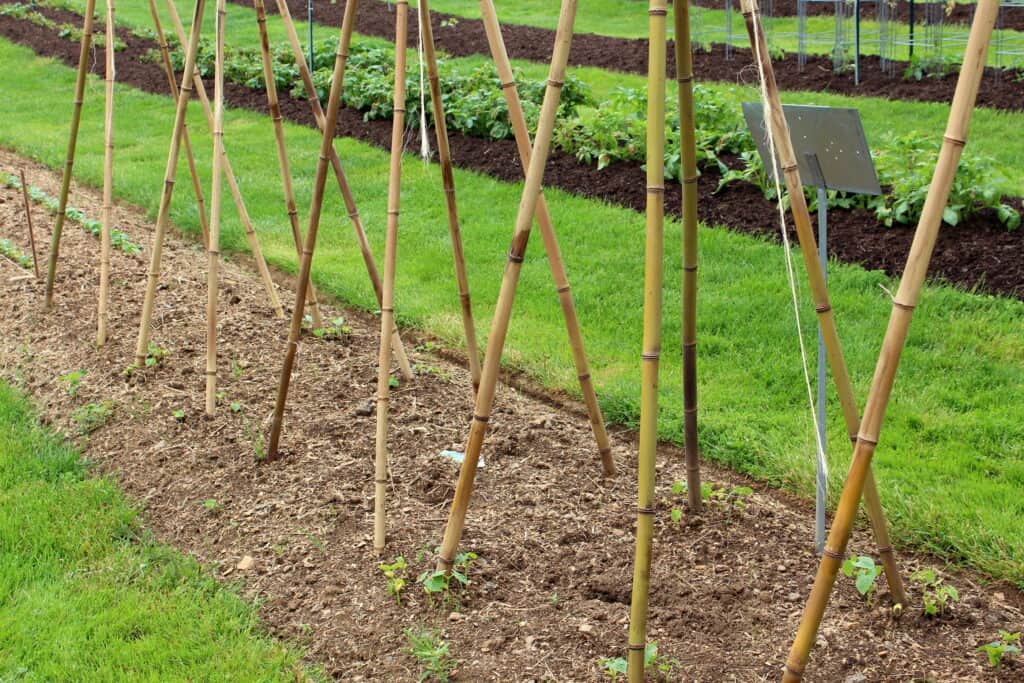As a seasoned gardener with years of hands-on experience growing beans in various climates and soil conditions, I’ve learned what works best for a bountiful harvest. Whether you’re growing beans for the first time or looking to refine your techniques, this guide is based on real-world experience, trial and error, and successful gardening methods.
I’ve grown both bush and pole beans in my garden, and each has its advantages. Bush snap beans are compact and perfect for small spaces, requiring no additional support. They mature quickly, and I often plant them in succession for continuous harvests. Pole snap beans, on the other hand, require trellises or stakes but reward you with an extended harvest period and higher yields. I always recommend pole beans for gardeners who have vertical space available.

Snap Bean Quick Growing Tips
Over the years, I’ve found these tips to be the most helpful for ensuring healthy, productive bean plants:
- Plant snap beans in full sun (at least 6-8 hours per day).
- Use well-draining, fertile soil with a pH of 6.0-6.8.
- Sow seeds directly in the garden after the last frost when soil temperatures reach at least 60°F—I’ve made the mistake of planting too early, and cold soil leads to poor germination.
- Water consistently, keeping soil evenly moist but not waterlogged. Overwatering can cause root rot, which I learned the hard way in my early gardening days.
- Provide support for pole beans using stakes, cages, or trellises.
- Harvest regularly to encourage more bean production—I pick mine every couple of days to keep plants producing.
Related articles:
- How to Plant and Grow Snap Beans for a Productive Harvest
- A Guide to Growing Snap Beans in Containers
- Types of Beans for Home Gardens
- Snap Bean Seed Starting Tips
- Snap Bean Varieties: Which One Should You Grow?
- Harvesting, Storing, and Cooking Snap Beans: A Gardener’s Guide
- The Ultimate Guide to Growing Beans: From Planting to Harvest
- Common Bean Pests and Diseases: What Every Gardener Should Know
Where to Plant Snap Beans
In my experience, choosing the right planting location is crucial. Beans thrive in loose, well-draining soil with plenty of organic matter. I prepare my beds by adding compost before planting, which improves soil fertility and water retention. Raised beds work exceptionally well, as they provide excellent drainage. Avoid planting beans where legumes have grown recently to prevent disease buildup.
Snap Beans Planting Time
I’ve found that timing is everything when planting snap beans. In my garden, I wait until the soil has warmed to at least 60°F—cold soil delays germination. Successive plantings every 2-3 weeks ensure a steady harvest throughout the growing season.
Bean Seed Pre-Planting Treatment
From experience, soaking snap bean seeds in warm water for a few hours before planting speeds up germination. If your soil lacks nitrogen, I recommend using a legume inoculant—I started doing this a few years ago, and it significantly improved my yields.
Planting and Spacing Snap Beans
- Bush Beans: Sow seeds 1 inch deep, spacing them 2-3 inches apart in rows 18-24 inches apart. I like to plant bush beans in blocks rather than rows to maximize space.
- Pole Beans: Sow seeds 1 inch deep and 4-6 inches apart at the base of trellises, poles, or teepees. When I grow pole beans, I use a simple teepee made from bamboo stakes—this has worked best for me over the years.

Succession Cropping Beans
To keep my harvest going, I plant bush beans every 2-3 weeks throughout the summer. Pole beans tend to produce over a longer period, so I don’t need as many succession plantings.
Watering Snap Beans
Beans need about 1 inch of water per week. I always water at the base of plants using a drip system or soaker hose to prevent wet foliage, which reduces the risk of disease.
Feeding Snap Beans
Snap beans fix their own nitrogen, so they don’t require heavy fertilization. I use compost or a balanced organic fertilizer to boost soil health without overfeeding.
Companion Plants for Snap Beans
Through trial and error, I’ve found that beans grow best alongside:
- Carrots, cucumbers, celery, and radishes (help deter pests)
- Corn (provides natural support for pole beans)
- Marigolds and nasturtiums (repel pests) I avoid planting beans near onions and garlic, as they inhibit growth.
More tips:
- Beans Seed Starting Tips
- Five Ways to Quick Cook and Serve Snap Beans
- How to Harvest and Store Snap Beans
- How to Can Green Snap Beans for Beginners
- Green Snap Beans with Galic

Caring for Snap Beans
- Mulch around plants to retain moisture and suppress weeds—I use straw or shredded leaves.
- Weed regularly to prevent competition for nutrients and water.
- Pinch back pole beans if they grow too tall for easy harvesting—I’ve found this helps keep them manageable.
Growing Snap Beans in Containers
For those with limited space, beans grow well in containers. I’ve successfully grown snap beans in 12-inch deep pots using a high-quality potting mix. Pole beans need a sturdy trellis, even in containers.
Snap Bean Pests
I’ve encountered these common pests over the years:
- Aphids (control with insecticidal soap or neem oil)
- Mexican bean beetles (handpick and destroy)
- Spider mites (spray leaves with water to reduce populations)
More tips: Bean Growing Problems: Troubleshooting.
Snap Bean Diseases
Diseases I’ve dealt with include:
- Rust (orange-brown spots on leaves—remove affected leaves and apply fungicide if needed)
- Powdery mildew (white powder on leaves—improving air circulation helps prevent this)
- Root rot (caused by overwatering—proper soil drainage is key)
Harvesting Snap Beans
In my experience, snap beans are best harvested when they are firm, crisp, and about 4-6 inches long. I pick them every couple of days to encourage more production.
Storing and Preserving Snap Beans
Over the years, I’ve tried various storage methods:
- Refrigeration: Store fresh beans in a plastic bag in the crisper drawer for up to a week.
- Freezing: Blanch beans for 2-3 minutes, then freeze in airtight containers.
- Canning: Snap beans can be pressure canned for long-term storage.
- Drying: Some varieties can be dried for use in soups and stews.
Snap Beans in the Kitchen
Snap beans are a staple in my kitchen. I use them in:
- Stir-fries
- Soups and stews
- Salads
- Casseroles
- Roasted or grilled as a side dish
Growing snap beans has been one of the most rewarding experiences in my garden. With proper planting, care, and harvesting, they provide a steady supply of fresh beans throughout the season. I hope my firsthand experience helps you achieve a successful bean harvest!
Q&A: Ultimate Guide to Growing Snap Beans from Seed to Harvest
Q: When is the best time to plant snap beans?
A: Snap beans should be planted after the last frost, once the soil has warmed up to about 65°F (18°C). Typically, this means planting in spring, about 1-2 weeks after the last frost date in your area. Beans are warm-weather crops, so planting them too early can lead to poor germination and stunted growth.
Q: How should I prepare my soil before planting snap beans?
A: Beans grow best in well-draining soil that’s rich in organic matter. Loosen the soil to a depth of about 8-12 inches and add compost or aged manure to provide essential nutrients. Beans fix their own nitrogen, so avoid using high-nitrogen fertilizers, as they can result in more leafy growth and fewer pods.
Q: How do I plant snap beans?
A: You can plant snap beans directly in the garden or in containers. Sow seeds 1 inch deep, spacing them about 3 to 5 inches apart in rows. For bush beans, space the rows about 12 to 24 inches apart. For pole beans, plant seeds near a trellis or support structure, spacing them 4 to 6 inches apart.
Q: How often should I water my snap beans?
A: Beans need consistent moisture, especially during germination and pod formation. Water deeply, ensuring the soil is moist to a depth of about 4-6 inches. Avoid overhead watering to prevent spreading diseases, and water early in the day to reduce evaporation. Be mindful not to overwater, as this can lead to root rot.
Q: How long does it take for snap beans to grow from seed to harvest?
A: Bush snap beans typically mature in about 50 to 60 days, while pole beans take slightly longer, around 60 to 70 days. The exact timing will depend on the variety and your growing conditions, but beans generally reach maturity when the pods are fully formed and the seeds inside begin to swell.
Q: When should I harvest snap beans?
A: Snap beans should be harvested when the pods are firm and crisp. They’re best picked when the beans inside are just starting to swell but are still tender and not fully mature. Harvesting beans too late can result in tough pods and beans that are less flavorful. For pole beans, keep harvesting as the pods mature, which encourages continued production.
Q: Can I grow snap beans in containers?
A: Yes! Snap beans are great for container gardening, especially bush varieties. Choose a container that’s at least 8 to 12 inches deep, and provide a sunny spot for the beans to thrive. Make sure the container has good drainage, and water regularly to keep the soil moist. Pole beans also grow well in containers with a trellis or support system.
Q: What are some common pests and diseases that affect snap beans?
A: Beans are prone to a few pests, including aphids, bean beetles, and caterpillars. Fungal diseases like powdery mildew and rust can also affect beans. To prevent problems, rotate your crops each year, keep your garden clean, and remove any infected plants promptly. Using row covers and practicing proper watering techniques can also reduce pest and disease issues.
Q: How can I store snap beans after harvesting?
A: Snap beans can be stored fresh in the refrigerator for up to a week. For longer storage, you can blanch and freeze beans. To do this, briefly submerge the beans in boiling water, then cool them in ice water before freezing. This process helps maintain their texture, color, and flavor.
Q: Can I plant snap beans again in the same spot next year?
A: It’s best not to plant beans in the same spot every year due to the risk of soil-borne diseases and pests. Rotate your crops by planting beans in a different area each year to help maintain healthy soil and reduce the buildup of pests or pathogens.
By following these answers and tips, you’ll be well on your way to growing a bountiful crop of snap beans, whether you’re a first-time gardener or a seasoned pro. Happy planting!
Books to help you grow:
- Vegetable Garden Almanac & Planner
- Kitchen Garden Grower’s Guide Vegetable Encyclopedia
- Vegetable Garden Grower’s Guide
- Tomato Grower’s Answer Book
Related articles:
How to Plant and Grow Snap Beans
How to Harvest and Store Snap Beans
Bean Growing Problems: Troubleshooting
Five Ways to Quick Cook and Serve Snap Beans
How to Can Green Snap Beans for Beginners
Cooking and Serving Yard-Long Beans
How to Grow Plant, Grow, and Harvest Chickpeas and Garbanzo Beans
How to Cook and Serve Chickpeas
How to Plant and Grow Lima Beans
How to Plant, Grow, and Harvest Broad Beans and Fava Beans
Five Ways to Cook and Serve Fava Beans
All About Dried Beans – Growing and Cooking
Container Growing Beans – Plant, Grow, and Harvest Tips
Garden Planning Books at Amazon:
- Vegetable Garden Almanac & Planner
- Kitchen Garden Grower’s Guide Vegetable Encyclopedia
- Vegetable Garden Grower’s Guide
- Tomato Grower’s Answer Book
More how to grow articles:
Learn how to plant, grow, and harvest your favorite vegetables. Click below for all you need to know.
- Artichoke
- Arugula
- Asparagus
- Beans, Snap
- Beets
- Broad Beans
- Broccoli
- Brussels Sprouts
- Cabbage
- Cantaloupe — Melons
- Cardoon
- Carrots
- Cauliflower
- Celeriac
- Celery
- Chard
- Chayote Squash
- Chickpeas
- Chicory
- Chinese Cabbage
- Collards
- Corn Salad
- Corn, Sweet
- Cresses
- Cucumbers
- Eggplant
- Endive and Escarole
- Fava Beans
- Florence Fennel
- Garbanzo Beans
- Garlic
- Horseradish
- Jerusalem Artichoke
- Kale
- Kohlrabi
- Leeks
- Lettuce
- Lima Beans
- Melons
- Mizuna
- Mustard Greens
- New Zealand Spinach
- Okra
- Onions
- Parsnips
- Peanuts
- Peas
- Peppers
- Potatoes
- Pumpkins
- Radicchio
- Radishes
- Rhubarb
- Rutabaga
- Salsify
- Shallots
- Sorrel
- Southern Peas
- Soybeans
- Spinach
- Squash, Summer
- Squash, Winter
- Sunchokes
- Sweet Potato
- Swiss Chard
- Taro
- Tomatillo
- Tomatoes
- Turnips
- Watermelon
- Zucchini



